LJ Create used a product design consultancy for the first time in its AutoBoard enclosure project. Tanya Weaver talks to both the consultant PDG Ltd and the client about their experiences of the product development process
The role of a product design consultancy is, in essence, to take a brief from a client and then work with them to produce a manufacturable, market-ready product.
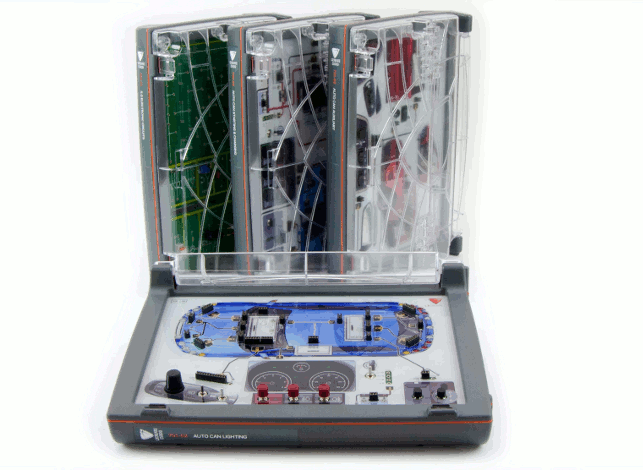
LJ Create’s new range of CAN BUS autotronics boards for use in schools and colleges
The design and development process consists of various stages, which may differ from consultancy to consultancy but basically follows: design brief, design specifications, concept design, detailed design, prototyping, testing, refinement and manufacture.
Although this process may be second nature to designers, what about their clients who have never undertaken a product development project before? It’s a case of guiding them through the process, building up a relationship of trust and managing their expectations, as Derbyshire product design consultancy PDG undertook recently in a project with new client LJ Create.
Norwich-based LJ Create are a provider of educational software and equipment to schools and colleges. Their range of automotive products, which consists of an enclosure in which circuit boards are placed to help train students, has been in use for 25 years and the company decided it was high time for a redesign.
“In starting to redesign the technology behind the auto boards we wanted the product to be enclosed in a stand-alone case, with modern styling. We also wished to redevelop a wider range of products and a single, multipurpose case seemed an obvious way of keeping costs down,” says Gary Bremer, LJ Create’s production manager.
LJ Create – bringing design onboard
Realising that they didn’t have the resources or manufacturing knowledge in-house to carry out such a product development project, LJ Create starting looking for a consultancy which would be able to help.
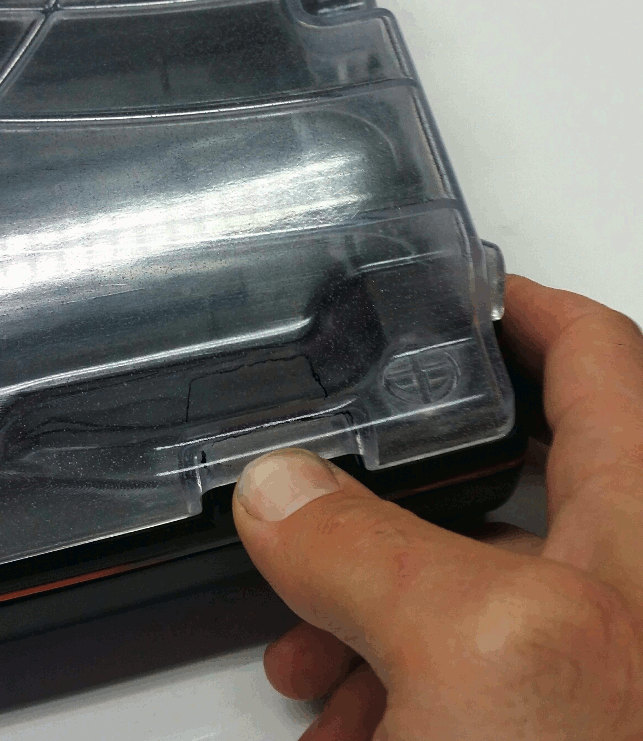
Various aspects of the design such as the catch mechanism took a lot of development work
“A company called Data Harvest produce a piece of equipment that we use and it had the type of features and styling that we wanted. We discovered that PDG were involved in the design of the moulded units so we approached them to ask if they would be interested in working with us to develop our own enclosure,” says Bremer.
Having met with the design team at PDG, the initial brief was fairly loose as LJ Create didn’t really know what was possible. “We gave them some approximate sizes, based on our existing products; an idea of what needed to fit inside the enclosure; an assumption for the end cost for production; and some idea of the functionality that we wanted from the case,” explains Bremer.
Although a loose brief may sound favourable, it actually proved to be quite challenging. PDG spent quite a long time creating a specification document to figure out exactly what they were being asked to design.
The enclosure would need to cater for 13 different PCBs, half of which hadn’t been designed yet. As well as tight guidelines on space allowed around the board, there were also various add-ons that hadn’t been designed yet as well as a docking station on the side.
“Although the brief was very open, there were quite a few general unknowns, which made it rather challenging,” comments Adam Hiron, PDG’s design manager.
A major consideration was the lid, which not only had to protect the board inside but also form a box for easy storage on the shelf. LJ Create also wanted a hinged lid that, when folded back, would lock in place and in so doing would tilt the board towards the user for ease of use.
PDG sketched four concepts that all looked robust and that PDG considered fitting for the automotive industry. However, LJ Create weren’t overly taken with any of them.
“They were pretty disappointed until we said to them that it’s absolutely fine for you not to like them. It’s as good as saying that this is the one you want because we now know exactly the style that you are not looking for,” says Drew Logan, PDG’s business manager.
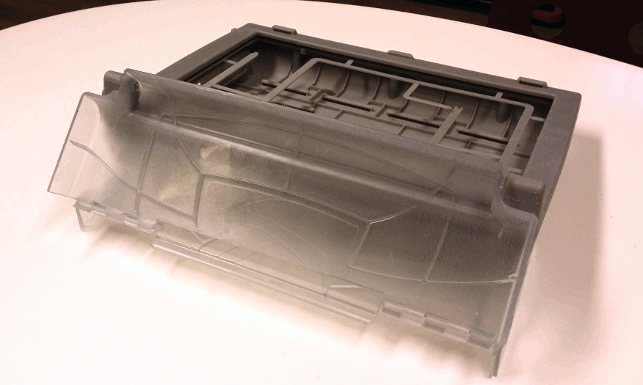
One of the early SLA prototypes of the enclosure showing the hinged lid
“We told them to trust us and as soon as we gave them another three with different versions of the hinging, they were all smiles again. Two of these concepts look like the end product and one looks like a fat iPad, which they requested and we could have made work but we had our reservations,” adds Logan.
PDG then went into CAD and created two development models using SolidWorks, which LJ Create could spin round and scrutinise in more detail.
“For us, this project was almost like a strategic reassurance process to make sure that LJ Create felt they could trust us and know that any sort of issues that come through development would be resolved. Generating that sort of faith with the client is one of the key things,” says Hiron.
LJ Create – learning curve
It was certainly a learning curve for LJ Create but PDG were guiding them through the process by explaining any terminology they were unfamiliar with and also the various decisions that needed to be made such as what materials and
the manufacturing methods would be best.
It was decided that they’d go down the injection moulding route and use polycarbonate over polypropylene, which was PDG’s preference as it would look better especially as LJ Create wanted a clear lid for their product.
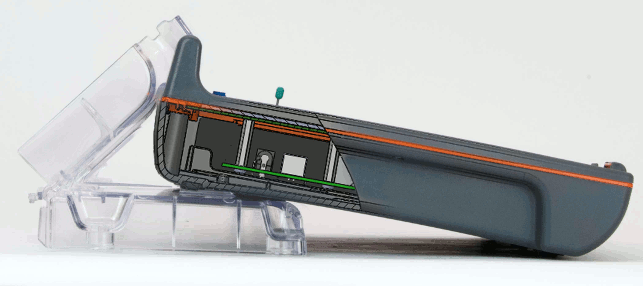
A SolidWorks model with an internal view
It was important to know this early on so that LJ Create would know the costs involved and PDG could then design the enclosure to suit the manufacturing method.
Once LJ Create selected their chosen design from the two CAD models, PDG then worked that one up in more detail.
Using SolidWorks the designers could create detailed geometry, see where interferences were going to be and create ribs to strengthen the lid. These were then shown to the client.
“The technical challenge with this project was being able to develop on the fly,” admits Hiron. “We would show LJ Create a certain aspect of the design and they might request changes. But this is often the case with a development project – the specifications develop with the process really.”
The final CAD file was then sent to Materialise over in Belgium, which produced a prototype using SLA (incidentally, this was one of the new terms that LJ Create hadn’t come across before).
PDG then used its in-house vacuum casting facilities to mould additional units using replica materials to that of ABS, polycarbonate and polypropylene in order to carry out tests on the enclosure.
Throughout the process LJ Create had their reservations about the strength of the lid and the hinge mechanism. So, when they received the prototypes they forced them until they broke to see just how strong it was.
“It was difficult for us to conceptualise the end result; all along, PDG provided comprehensive explanations of how the hinge mechanism would work. It was only when we had the enclosure in our hands that we were able to express our concern of how the end users might handle the product.
“No matter how many drawings you look at, there’s nothing like evaluating a design when it’s in your hands,” says Bremer.
But this is the point of prototypes – to evaluate the design and make changes before committing to tooling.
“Polycarbonate will shatter if enough force is applied but the client still wanted the lid and hinge mechanism to be stronger. Changes to the design were made both in CAD environment as well as on a prototype set which were then reverse engineered into the design.” comments Logan.
“The benefit of early prototypes and ‘breaking’ the hinge all helped to improve the design to the point where we were happy to continue with production quantities,” adds Bremer.
PDG selected a manufacturer they work with on a number of other products they produce, which is based in Leicester.
“We did get quotes from China but it proved to be more expensive than over here, which for low volume items is something we come across regularly. Leicester means we can get there in 45 minutes and the client can get there easily too,“ explains Logan.
LJ Create were more than pleased with this decision. “To have a manufacturer in a different country would have introduced delays, potential for confusion and, ultimately, would probably have proved a false economy,” says Bremer.
But a problem arose once the tool had already been processed and cutting underway. LJ Create discovered that marks were appearing on the top surface due to a part of the base coming into contact with the lid.
Of course LJ Create wanted the product to be perfect and these final tweaks to the design were the most challenging part of the project as it inevitably resulted in more time spent and more cost.
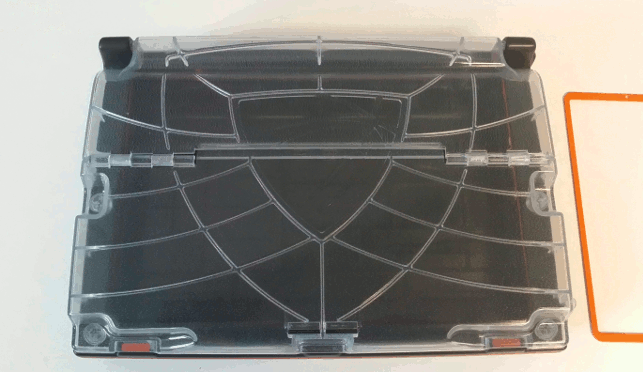
The hinged lid was the most challenging aspect of the design
“Although we welcomed changes made by PDG to overcome the issues through tooling changes, the alternative solutions were limited without avoiding drastic changes or significant additional time and cost,” says Bremer.
After all the tooling modifications had been completed, the first production run went ahead; with the final products being well received by both LJ Create and their customers.
“The enclosure has the wow factor when compared to the previous design and is exactly the impression we wanted to achieve.
“Having taken delivery of the first batch of manufactured cases, the integration into a wide range of new products is now full steam ahead and these will be available to customers soon,” says Bremer.
Although early feedback has been favourable, LJ Create are still hesitant to announce the enclosure to be a total success. Some outstanding risks include whether breakages or malfunctions will occur after a certain period of time.
Will it go through a batch production assembly run without problems? Will the future proofing for a docking station prove to be successful?
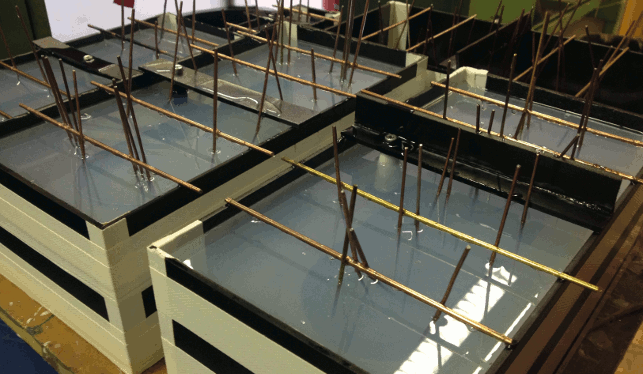
PDG utilised their in-house vacuum casting facility to produce prototypes of the AutoBoard enclosure
Time will tell but LJ Create has certainly not been put off embarking on a product development project again. It has a few projects in the pipeline and will definitely consider outsourcing the design to PDG. But this being the first time, what would they do differently next time?
“Understanding how the process worked for us this time will smooth the planning and decision making for the next project and I would like to think that there would be a much clearer vision of how the product would turn out,” says Bremer.
From PDG’s point of view, this project did take a little longer than some, but now that they’ve been through one project together, the next one will be more plain sailing. “It is just about forming that relationship with new clients – everybody works in different ways and it’s how we can fit together,” concludes Logan.
Top tips
PDG provide five tips for product design consultancies working on a project with a client that has never used the services of a consultancy before.
1 Make sure you have material samples and examples of design and technology features to show your client as a physical ‘proof of concept’ for the various elements of the end product.
2 Don’t make the assumption that clients know the process of developing a product from concept to manufacture, and be prepared to explain why each step is necessary in creating a successful end product.
3 Imagery is important when explaining design features, finishes, and material choices. A physical meeting, video call, or email with appropriate imagery saves time and confusion.
4 As far as possible, explain the benefits and limitations of the intended manufacturing process as early on as possible so that your client understands why specific design decisions have been made.
5 Establish the intended future use of the end product so that flexibility can be considered and designed in. A specification document drawn up between both parties is a perfect way of doing this.






